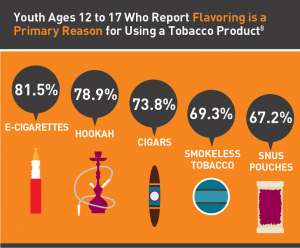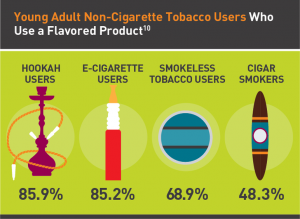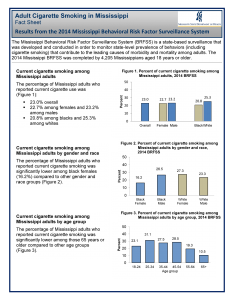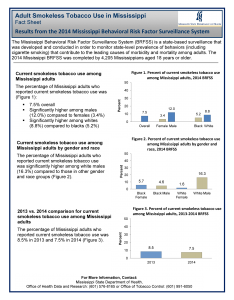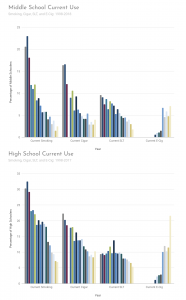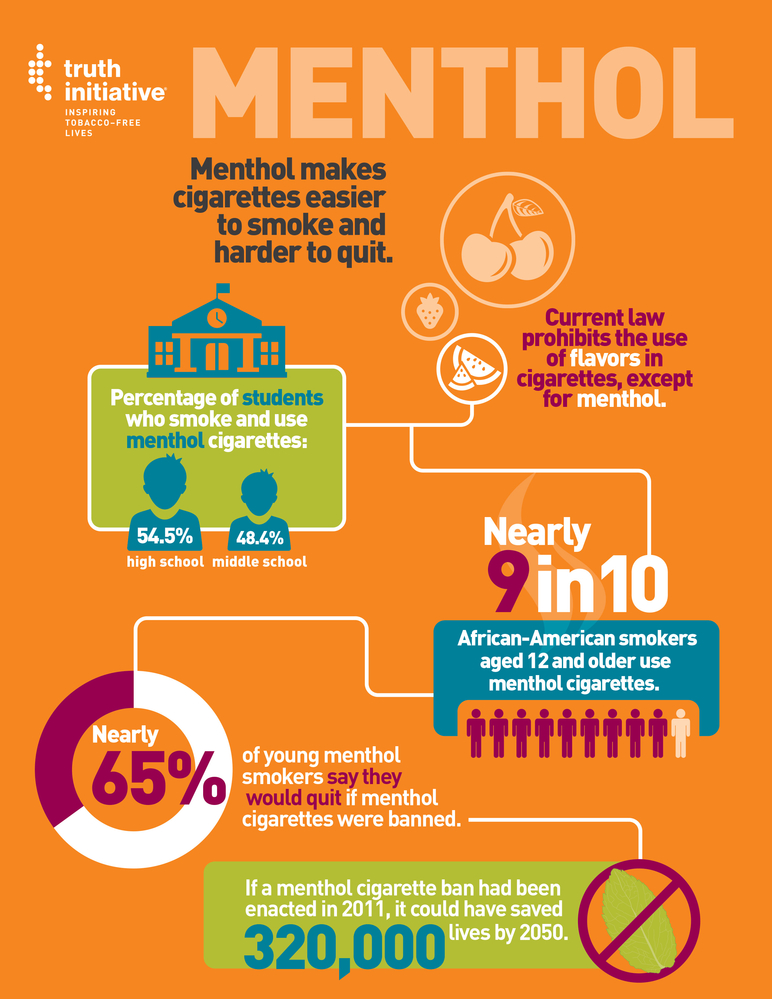African Americans and Tobacco Use
- African American youth and young adults have significantly lower prevalence of cigarette smoking than Hispanics and Whites
- Although the prevalence of cigarette smoking among African American and White adults is the same, African Americans smoke fewer cigarettes per day.
- On average, African Americans initiate smoking at a later age compared to Whites.
- African American children and adults are more likely to be exposed to secondhand smoke than any other racial or ethnic group.
- During 2011–2012, secondhand smoke exposure was found in:
- 67.9% of African American children aged 3–11 years.
- 54.6% of African American adolescents aged 12–19 years.
- 39.6% of African American adults aged 20 years and older.
- African American nonsmokers generally have higher cotinine levels (an indicator of recent exposure to tobacco smoke) than nonsmokers of other races/ethnicities.12
- Nearly 15 of every 100 non-Hispanic Blacks (14.9%)
MS Youth Tobacco Survey Data
E-Cigarettes
- Current e-cigarette use among public middle school students has increased by 1083% since 2010, leading to 7,096 more young e-cigarette users
- Current e-cigarette use among public high school students has increased by 1700% since 2010, leading to 26,623 more young e-cigarette users
- The prevalence of having ever tried using e-cigarettes has increased by 1744% since 2010, leading to 17,138 more middle school students who have tried using e-cigarettes.
- The prevalence of having ever tried using e-cigarettes has increased by 1900% since 2010, leading to 47,112 more high school students who have tried using e-cigarettes.
- Frequent e-cigarette use has increased by 313% since 2014, leading to 6,525 more high school students who have used an e-cigarette on at least 20 of the past 30 days.
MS Youth Tobacco Survey Data
Standard Cigarette
- Tobacco use among Mississippi youth has decreased substantially since statewide tobacco control programs were implemented in 1999.
- Current smoking among public middle school students has decreased by 88% since 1998, leading to 19,758 fewer young smokers.
- Current smoking among public high school students has decreased by 77% since 1998, leading to 30,538 fewer young smokers.
- The prevalence of having ever tried smoking has decreased by 76% since 1998, leading to 45,193 fewer middle school students who have tried smoking.
- The prevalence of having ever tried smoking has decreased by 65% since 1998, leading to 64,077 fewer high school students who have tried smoking.
- Frequent smoking has decreased by 96% since 1998, leading to 5,458 fewer middle school students who have smoked a cigarette on at least 20 of the past 30 days.
- Frequent smoking has decreased by 87% since 1998, leading to 16,182 fewer high school students who have smoked a cigarette on at least 20 of the past 30 days.
MS Youth Tobacco Survey Data
Smokeless Tobacco
- Current smokeless tobacco (SLT) use among public middle school students has decreased by 81% since 1998, leading to 8,515 fewer young SLT users.
- The prevalence of having ever tried SLT has decreased by 67% since 1998, leading to 13,209 fewer middle school students who have tried SLT.
- The prevalence of having ever tried SLT has decreased by 51% since 1998, leading to 17,357 fewer high school students who have tried SLT.
- Frequent SLT use has decreased by 86% since 1998, leading to 2,074 fewer middle school students who have used SLT on at least 20 of the past 30 days.
Truth Initiative
Menthol
What Is Menthol?
Menthol is a chemical compound extracted from peppermint or corn mint plants, or created synthetically. It reduces the harshness of cigarette smoke due to its characteristic cooling effects on the mouth and throat. It also suppresses the coughing reflex, which makes inhaling smoke from cigarettes more tolerable.
Menthol was first added to cigarettes in the 1920s and 1930s, and became widespread in the 1950s and 1960s. Although most cigarettes contain some menthol, certain brands use menthol in greater quantities, making it detectible as a characterizing flavor. Tobacco manufacturers market and advertise those brands as “menthol cigarettes.”
Patterns of Use in the U.S.
- In 2016, 7.26 percent of people aged 12 or older used menthol cigarettes.
- For adult smokers aged 18 and older, there were significant increases in menthol cigarette use from 2008 to 2014.
- Youth smokers remain the age group most likely to use menthol cigarettes.
- Among current cigarette smokers (those who have smoked in the past 30 days), 39 percent used menthol cigarettes from 2012 to 2014, compared with 35 percent from 2008 to 2010.
- Menthol cigarette smoking is more prevalent among smokers who are young, female, part of a sexual minority, or part of a racial or ethnic minority. There is also significant menthol use among smokers with mental illness.
- African-American smokers predominantly use menthol cigarettes. Nearly 9 in 10 African-American smokers (88.5 percent) aged 12 and older use menthol cigarettes.
Youth and Young Adults
- Menthol reduces the harshness of cigarette smoke, which may appeal to young, inexperienced smokers.
- Longitudinal studies show that initiation with menthol cigarettes facilitates progression to established cigarette use among young smokers.
- Data from nationally representative samples show that the youngest cigarette smokers use menthol at the highest rates.
- Menthol cigarette use among youth and young adult smokers was greater than non-menthol cigarette use in 2014.
- In 2014, the prevalence of menthol cigarette use among current cigarette users was 54.5 percent among all high school students and 48.4 percent among all middle school students.
- A nationally representative study found that, among youth and young adults, non-menthol cigarette prevalence declined from 2004 to 2010. By contrast, menthol cigarette prevalence remained constant among youth and increased among young adults over this period.
- Menthol cigarette use is higher among young adult smokers than older adult smokers. Among adults surveyed from 2012 to 2014, current smokers aged 18-25 had the highest prevalence of menthol cigarette use at 50 percent.
Truth Initiative
JUUL
One JUUL pod contains 20 cigarettes worth of nicotine.
The amount of nicotine in one JUUL cartridge is roughly equal to the amount of nicotine in a pack of cigarettes, or about 200 puffs, according to the product website. While less toxic than combustible cigarettes, e-cigarettes can make youth more likely to use cigarettes and still contain toxins and the addictive chemical nicotine, which is harmful to adolescent brain development.
Almost one-fifth of middle and high school students have seen JUUL used in school.
JUUL is easy to hide because it looks like a flash drive and can be charged in a USB port. It also does not produce a strong odor. These characteristics enable discreet use, especially in schools. Almost one-fifth of middle and high school students have seen JUUL used in school, according to an April 2018 Truth Initiative® survey of more than 1,000 youth between 12 and 17 years old.
- A 2017 study by the Truth Initiative Schroeder Institute® found that 6 percent of youth and 10 percent of young adults have used a JUUL e-cigarette in the last 30 days. The study also found that while many young people are aware of JUUL, many are unaware that the product always contains the addictive chemical nicotine.
- Twenty-five percent of survey respondents aged 15 to 24 recognized a JUUL e-cigarette device when shown a photo of the product.
- Among those who recognized JUUL, 25 percent reported that use of this product is called “JUULing,” indicating that this product is so distinctive, it is perceived as its own category.
- Sixty-three percent of JUUL users did not know that this product always contains nicotine.


